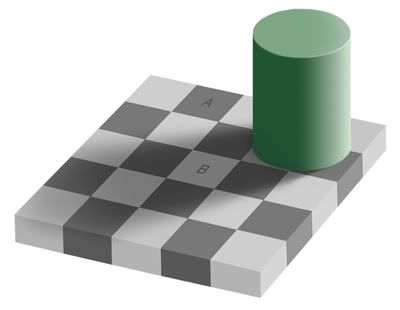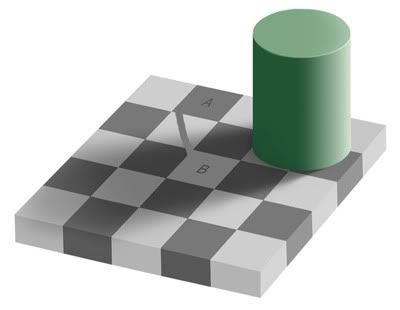An Optical Illusion
As a person who has an interest in the nature of perception, and also as an artist, I have been long fascinated by optical illusions. I've seen a lot of them, but this one caught my attention today as I was looking up 'darkness' as a wiki entry:

Square A is the same shade as square B.
It seems unbelievable, but it's true.
I'm pretty familiar with the concept of relative shading but I thought I would do a little experiment. Despite the impression of different values in my mind from seeing this picture, I was fully confident that the author was correct (having seen a similar illustration before) and they were the same shade. However, just for fun, I copied the pic and pasted it in my photoshop program. Then I took the eyedropper tool and sampled both squares. Lo and behold, all Red Green and Blue attributes were 120 for both squares, an exact match.
Then to see how it would look, I took the paintbrush with the sampled color selected and did this:

It is interesting that the effect of gradation is a complete illusion. It looks like a smooth blend, doesn't it?
In fact, if you relax your focus and stare somewhere in the middle of the two squares you might see the two blocs and their connecting line as a whole pop out of the background.

The nature of perception sure is neat.
What's even more interesting is how the lesson of this simple visual trick can be used to extrapolate other facts in the areas of life. There are certain redundancies or patterns in existence, and what is observed in the visual realm can be also observed in other realms. Not only in our external senses, light, sound, (energy), ect., but within our minds as well, especially since all of our senses are filtered through interpretative mechanisms that apply subjective meaning and causality to the things we experience. In short, how the mind perceives the stimuli and puts together a mental representation of it, (as viewing is an active process, not a passive one), those same mechanisms may also be similar to how we consider abstract concepts.
So, despite how it looks, the two squares are the same but only appear different simply by the contrasting values around them.
Makes you wonder, then, what other things in life are actually the same but which their sameness is obscured by the particular framing, intentional or otherwise, of the environments around them?



9 Comments
Recommended Comments